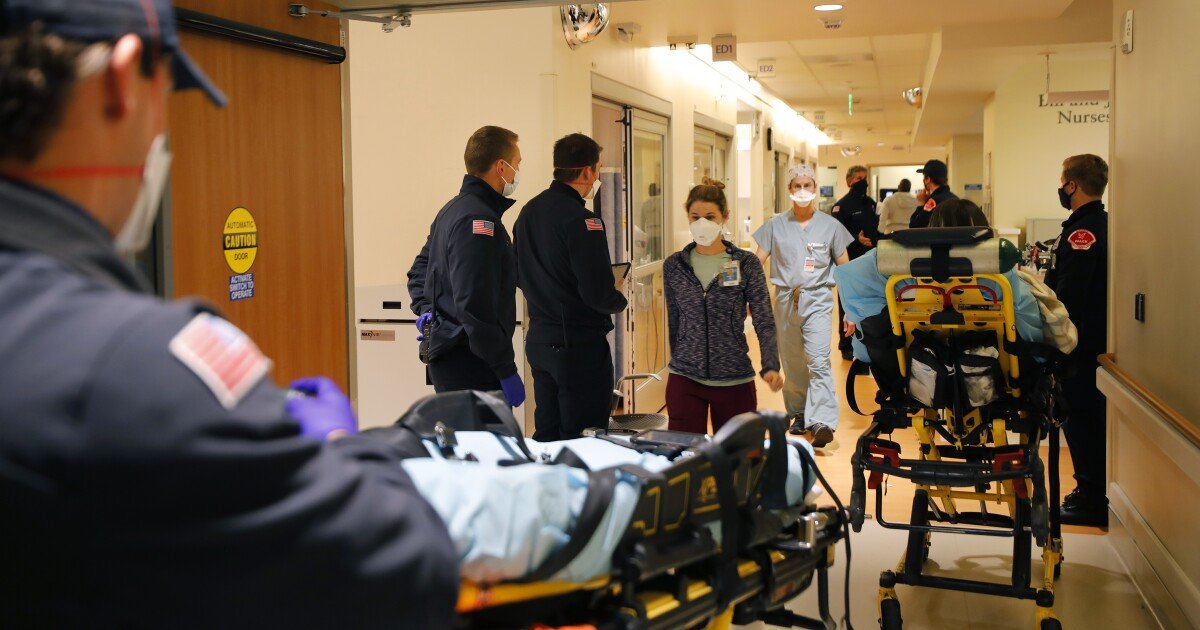Extraordinary number of sick health care workers pushes hospitals to brink – The San Diego Union-Tribune
Unprecedented numbers of sick medical staff are causing gridlock in hospitals across San Diego County, significantly hampering efforts to efficiently treat the large number of residents coming forward for care amid continuing increases in the number who are testing positive for COVID-19.
The county health department reported 7,786 new positive cases Tuesday, down slightly from Monday’s total of 8,313. Too many of those positive test results, though, have been for health care workers, the people the community needs most to make it through the current coronavirus surge.
Chris Van Gorder, chief executive officer of Scripps Health, said in an email that an unprecedented 14.5 percent of the health system’s workforce, about 700 workers, including more than 400 in clinical roles, were out on unscheduled time off as of Tuesday afternoon.
“I never like to use the word crisis, but I’ve never seen a staffing issue this serious before, even last year when COVID admissions were much higher,” Van Gorder said. “We just passed the holidays; it’s bound to get worse before it starts to get better.”
Those words carried extra weight as the day drew to a close and Scripps notified local and state public health authorities that its Chula Vista hospital is so impacted that the facility might need to declare an internal disaster, a term that indicates patient care could be affected and additional resources from outside sources may be needed. No additional details were available Tuesday evening.
It appeared that the county emergency services department’s prohibition on ambulance diversion, a practices that allows hospitals to temporarily stop taking out-of-area patient deliveries, expired as planned at 8 a.m. Tuesday, though the department did not confirm the status.
Patricia Maysent, chief executive officer of UC San Diego Health, said the university system has had more than 500 health care workers test positive over the past seven days, a number that has forced some departments to operate at as little as half capacity.
“This is the first time, from the very beginning of the COVID pandemic, that I’m actually worried that we don’t have enough staff to take care of the patients,” Maysent said.
The current staffing situation was easily visible Monday night at Scripps Memorial Hospital La Jolla.
At about 9 p.m. Monday, Dr. Eric Barroso scrutinized the list of patients filling the facility’s 47 emergency beds, noting with frustration that 25 were marked with a light purple color, signifying that they were ready to be admitted to the main hospital.
Unable to keep the frustration from his voice, the physician described the helpless feeling that comes from having 30 or 40 patients in the waiting room while so many were ready, but unable to move along.
“Those are the patients that have already been admitted to the hospital that shouldn’t be down here anymore, and that’s half of our ER,” Barroso said.
And it wasn’t that there were no beds available to take them, explained Dr. Martin Griglak, one of Barroso’s emergency medicine colleagues. Too many health care workers called in sick after testing coronavirus positive, significantly reducing the number of beds in the main hospital that have staffing available.
And the usual methods of freeing up space were not working well. Health care is a tightly integrated chain of specialized personnel designed to keep patients moving. But at the moment, staffing difficulties are eroding capacity at every level.
“It all has a domino effect,” Griglak said. “We talk to hospital administration about trying to discharge some of the patients who are ready to go to skilled nursing, but there are not beds there either.”
Scripps Health said its hospitals are increasingly rescheduling non-emergency surgeries and procedures and UC San Diego Health and Sharp HealthCare said Tuesday they are taking similar measures to cope with the critical loss of staff to illness. Kaiser Permanente San Diego, Tri-City Medical Center in Oceanside and Palomar Health in inland North County said they have not yet had to take similar measures.
Like Scripps, Maysent said that low staffing numbers have forced UCSD to pull back on scheduled surgeries and procedures, with 27 operating room bookings delayed this week and potentially many more to come if the numbers on sick leave continue to mount as expected.
Last year, hospitals were under public health orders to put off as many non-emergency procedures as possible to make room for COVID-19 cases. That move ended up creating a massive backlog of work that many in health care say is one of the main reasons why the demand for non-COVID care was so high in 2021. Having similar delays occur again this year, many are saying with weariness, has the potential to put health care in catch-up mode for another year.
“It’s sort of a sad state right now, because I think that’s partially why we’ve had such an incredible demand for non-COVID (care) the last year is so many people were put off in 2020,” Maysent said. “It really hurts to be in that position again.”
What happens if staffing levels degrade substantially from their already-broken levels?
Hospitals have disaster plans that allow them to ask for additional help from the government as was the case in 2020 with El Centro Regional Medical Center in Imperial Valley. One lever left to pull, Maysent said, involves shifting non-hospital care to telemedicine as much as possible and pulling internal medicine workers into hospitals to help fill empty spots. Many facilities did just that last winter, though the reason was due to a massive number of very-sick COVID-19 patients requiring care rather than the sick workforce that is currently snarling the health care system.
Severe COVID-19 symptoms, hospital workers continue to say, are most often appearing in those who are unvaccinated. Many have expressed a lack of concern about COVID-19, especially as preliminary reports have found that those infected with the new Omicron variant seem to have less-severe symptoms than have been caused by other variants.
But it was plain to see Monday night at Scripps La Jolla that while most of the patients in the ER waiting room had relatively mild symptoms, several beds were filled with patients, including one in their 50s and another in their 40s, who came in with very-low oxygen levels, eventually needing intensive care admission.
Dr. Lisa Morikado, the emergency medicine specialist caring for one of the patients Monday, said she has met too many patients who were correct that they were unlikely to end up seriously ill but who ended up being part of the small minority on the wrong side of those odds. It’s hardest, she said, seeing serious consequences among those who have chosen not to increase their chances of a mild case by getting vaccinated.
She recalled a recent 62-year-old patient who decided he would do better getting infected than getting the vaccine. He just got out of the intensive care unit three weeks ago after nearly losing his bout with the virus and likely will never work again.
“He was intubated and had two strokes, his kidneys failed, and that’s the catch; you do well unless you don’t,” she said. “There’s nothing we can tell you.”
Follow Us
Follow Us
Privacy Policy
Terms of Service
Sign Up For Our Newsletters
Follow Us



